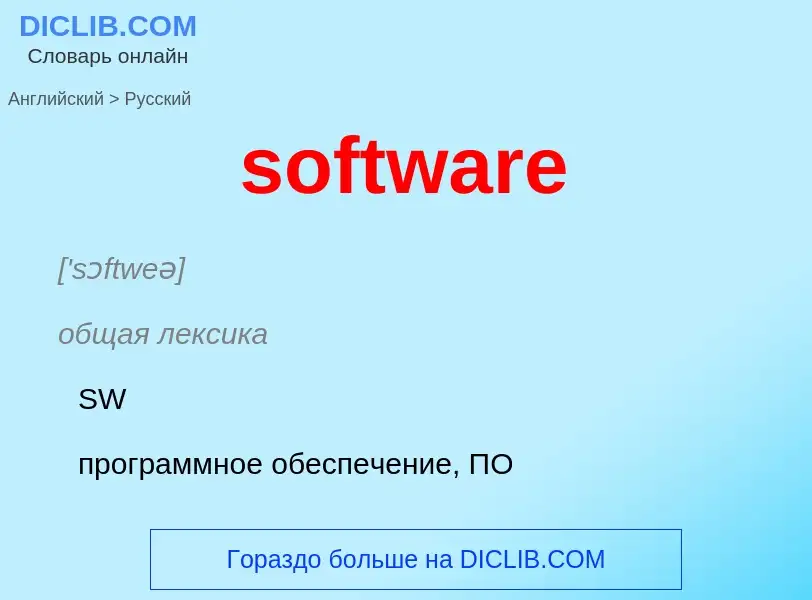Translation and analysis of words by artificial intelligence
On this page you can get a detailed analysis of a word or phrase, produced by the best artificial intelligence technology to date:
- how the word is used
- frequency of use
- it is used more often in oral or written speech
- word translation options
- usage examples (several phrases with translation)
- etymology
software - translation to English
['sɔftweə]
общая лексика
SW
программное обеспечение, ПО
общее понятие, описывающее программы для компьютеров в отличие от его аппаратных составляющих (hardware). При этом не уточняется, в каком виде представлены программы (в исходных текстах или в исполняемом коде). ПО делится на два больших класса - системное (system software) и прикладное ПО (application programs). К системному относится любое ПО, необходимое для разработки и исполнения программ, такое как операционные системы (operating system), компиляторы (compiler), отладчики и т.д. Примером прикладных программ могут служить программы бухгалтерского учета, обучающие программы, компьютерные игры, САПР и т.д. Программы, хранящиеся в энергонезависимой памяти (ПЗУ, ППЗУ), обычно называются firmware. По способу распространения ПО делится на бесплатное (freeware), условно-бесплатное (shareware) и коммерческое. Кроме того, ПО можно разделить на массовое, коробочное и заказное. Термин software впервые появился в 1958 г. в American Mathematical Monthly в статье математика из Принстонского университета Джона Туки (John Tukey)
программное обеспечение ЭВМ
программный
разговорное выражение
софт
вычислительная техника
матобеспечение
нефтегазовая промышленность
программное обеспечение
существительное
общая лексика
компьютерные программы
вычислительная техника
программное или математическое обеспечение
программные средства
- access control checking software
- advanced software
- anti-virus software
- benign software
- bugged software
- copy-protected software
- copyrighted software
- cryptoanalytic software
- data security software
- encryption software
- illegally copied software
- insecure software
- kernel software
- logical software
- malicious software
- memory-resident antivirus software
- network software
- non-kernel software
- password-protected software
- pirated software
- protected software
- protection software
- residual software
- secure access management software
- security software
- security-related software
- self-developed software
- Trojan horse software
- trusted software
- verified software
- virus-infected software
- virus-killing software
- virus protection software
2) программное [математическое] обеспечение, средства программирования
3) немашинная часть, неаппаратная часть (в комплексе аппаратуры)
4) военно-вещевое снабжение
5) услуги нематериального характера (образование, медицинская помощь, научные исследования), непроизводственные услуги
Wikipedia
Software is a set of computer programs and associated documentation and data. This is in contrast to hardware, from which the system is built and which actually performs the work.
At the lowest programming level, executable code consists of machine language instructions supported by an individual processor—typically a central processing unit (CPU) or a graphics processing unit (GPU). Machine language consists of groups of binary values signifying processor instructions that change the state of the computer from its preceding state. For example, an instruction may change the value stored in a particular storage location in the computer—an effect that is not directly observable to the user. An instruction may also invoke one of many input or output operations, for example, displaying some text on a computer screen, causing state changes that should be visible to the user. The processor executes the instructions in the order they are provided, unless it is instructed to "jump" to a different instruction or is interrupted by the operating system. As of 2023, most personal computers, smartphone devices, and servers have processors with multiple execution units, or multiple processors performing computation together, so computing has become a much more concurrent activity than in the past.
The majority of software is written in high-level programming languages. They are easier and more efficient for programmers because they are closer to natural languages than machine languages. High-level languages are translated into machine language using a compiler, an interpreter, or a combination of the two. Software may also be written in a low-level assembly language that has a strong correspondence to the computer's machine language instructions and is translated into machine language using an assembler.

